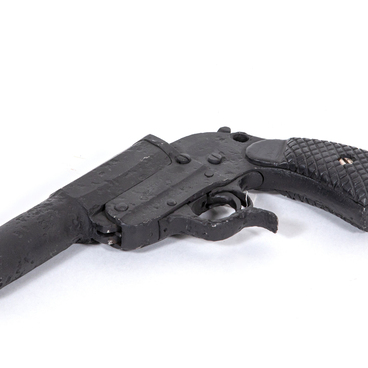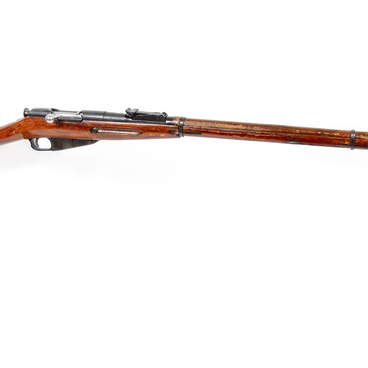The bayonet for the 1940 Tokarev self-loading rifle was found during battlefield excavations, conducted in 2008-2010 in the Nelidovsky district, Tver Oblast by the Noyabrsk joint search party ‘Vitalis’ under the leadership of Natalia Usenko.
The bayonet for the SVT-40 consists of a blade, a hilt, and a pommel. This is a single-edged model. It has a fuller — longitudinal groove along the flat side of the blade, which makes the bayonet lighter without reducing its strength. The hilt is made of two wooden pieces fastened to the tang with two screws.
The bayonet has special devices for attaching to the rifle: a straight cross-section with a ring, located on the blade backside, and the T-shaped groove with a locking spring on the grip of the hilt. The letter ‘M’ was hand-engraved on the wooden part of the handle. There is an unreadable manufacturer’s branding on the blade’s end.
The domestically made small arms of the first half of the 20th century were issued with bayonets. For example, the 1891 Mosin–Nagant rifle and 1891/1930 model, as well as the 1944 carbine Mosin-Nagant, had quadrilateral socket bayonets. The 1936 Simonov automatic rifle and the 1938 and 1940 Tokarev self-loading rifles had knife bayonets.
The displayed bayonet was a part of a modernized variant of the 1938 Tokarev self-loading rifle, adopted by the Red Army in April 1940. Primarily, it was important to reduce the size and weight of the rifle. Initially, it was planned to shorten the weapon by cutting the barrel. However, tests showed that such changes led to rifle malfunctions. Therefore, it was decided to reduce the length of the bayonet.
The bayonet for the SVT-40 differed from the 1938 model not only by its overall length and size of the blade, but it also had a small safety mechanism on the handle. During hand-to-hand combat with bayonets, the enemy could press the bayonet lug with their weapon, thus practically disarming the soldier with the SVT-38. The SVT-40 mechanism almost completely covered the bayonet lug from above, behind, and below. It reduced the risk of losing the bayonet in the fight.
The bayonet for the SVT-40 consists of a blade, a hilt, and a pommel. This is a single-edged model. It has a fuller — longitudinal groove along the flat side of the blade, which makes the bayonet lighter without reducing its strength. The hilt is made of two wooden pieces fastened to the tang with two screws.
The bayonet has special devices for attaching to the rifle: a straight cross-section with a ring, located on the blade backside, and the T-shaped groove with a locking spring on the grip of the hilt. The letter ‘M’ was hand-engraved on the wooden part of the handle. There is an unreadable manufacturer’s branding on the blade’s end.
The domestically made small arms of the first half of the 20th century were issued with bayonets. For example, the 1891 Mosin–Nagant rifle and 1891/1930 model, as well as the 1944 carbine Mosin-Nagant, had quadrilateral socket bayonets. The 1936 Simonov automatic rifle and the 1938 and 1940 Tokarev self-loading rifles had knife bayonets.
The displayed bayonet was a part of a modernized variant of the 1938 Tokarev self-loading rifle, adopted by the Red Army in April 1940. Primarily, it was important to reduce the size and weight of the rifle. Initially, it was planned to shorten the weapon by cutting the barrel. However, tests showed that such changes led to rifle malfunctions. Therefore, it was decided to reduce the length of the bayonet.
The bayonet for the SVT-40 differed from the 1938 model not only by its overall length and size of the blade, but it also had a small safety mechanism on the handle. During hand-to-hand combat with bayonets, the enemy could press the bayonet lug with their weapon, thus practically disarming the soldier with the SVT-38. The SVT-40 mechanism almost completely covered the bayonet lug from above, behind, and below. It reduced the risk of losing the bayonet in the fight.

